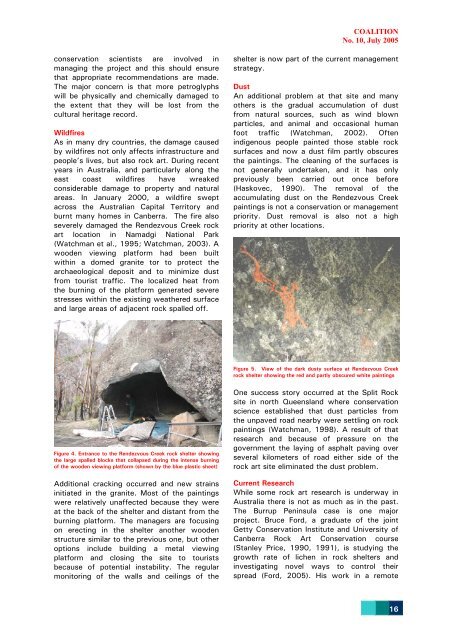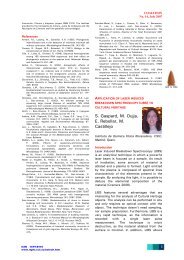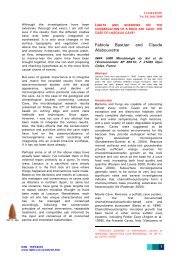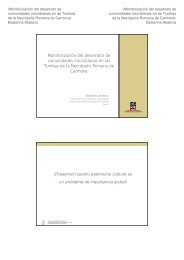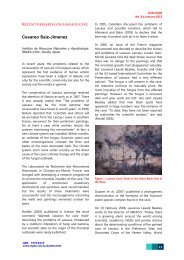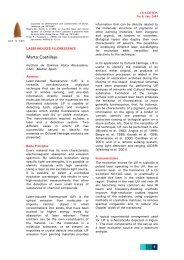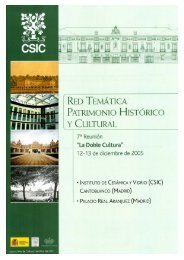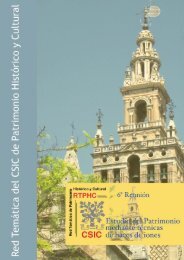Alan Watchman
Alan Watchman
Alan Watchman
- No tags were found...
You also want an ePaper? Increase the reach of your titles
YUMPU automatically turns print PDFs into web optimized ePapers that Google loves.
COALITIONNo. 10, July 2005conservation scientists are involved inmanaging the project and this should ensurethat appropriate recommendations are made.The major concern is that more petroglyphswill be physically and chemically damaged tothe extent that they will be lost from thecultural heritage record.WildfiresAs in many dry countries, the damage causedby wildfires not only affects infrastructure andpeople’s lives, but also rock art. During recentyears in Australia, and particularly along theeast coast wildfires have wreakedconsiderable damage to property and naturalareas. In January 2000, a wildfire sweptacross the Australian Capital Territory andburnt many homes in Canberra. The fire alsoseverely damaged the Rendezvous Creek rockart location in Namadgi National Park(<strong>Watchman</strong> et al., 1995; <strong>Watchman</strong>, 2003). Awooden viewing platform had been builtwithin a domed granite tor to protect thearchaeological deposit and to minimize dustfrom tourist traffic. The localized heat fromthe burning of the platform generated severestresses within the existing weathered surfaceand large areas of adjacent rock spalled off.shelter is now part of the current managementstrategy.DustAn additional problem at that site and manyothers is the gradual accumulation of dustfrom natural sources, such as wind blownparticles, and animal and occasional humanfoot traffic (<strong>Watchman</strong>, 2002). Oftenindigenous people painted those stable rocksurfaces and now a dust film partly obscuresthe paintings. The cleaning of the surfaces isnot generally undertaken, and it has onlypreviously been carried out once before(Haskovec, 1990). The removal of theaccumulating dust on the Rendezvous Creekpaintings is not a conservation or managementpriority. Dust removal is also not a highpriority at other locations.Figure 5. View of the dark dusty surface at Rendezvous Creekrock shelter showing the red and partly obscured white paintingsFigure 4. Entrance to the Rendezvous Creek rock shelter showingthe large spalled blocks that collapsed during the intense burningof the wooden viewing platform (shown by the blue plastic sheet)Additional cracking occurred and new strainsinitiated in the granite. Most of the paintingswere relatively unaffected because they wereat the back of the shelter and distant from theburning platform. The managers are focusingon erecting in the shelter another woodenstructure similar to the previous one, but otheroptions include building a metal viewingplatform and closing the site to touristsbecause of potential instability. The regularmonitoring of the walls and ceilings of theOne success story occurred at the Split Rocksite in north Queensland where conservationscience established that dust particles fromthe unpaved road nearby were settling on rockpaintings (<strong>Watchman</strong>, 1998). A result of thatresearch and because of pressure on thegovernment the laying of asphalt paving overseveral kilometers of road either side of therock art site eliminated the dust problem.Current ResearchWhile some rock art research is underway inAustralia there is not as much as in the past.The Burrup Peninsula case is one majorproject. Bruce Ford, a graduate of the jointGetty Conservation Institute and University ofCanberra Rock Art Conservation course(Stanley Price, 1990, 1991), is studying thegrowth rate of lichen in rock shelters andinvestigating novel ways to control theirspread (Ford, 2005). His work in a remote16


